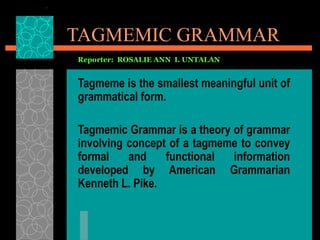
Tagmeme is the Smallest Meaningful Unit of Grammar
- 1. TAGMEMIC GRAMMAR Reporter: ROSALIE ANN I. UNTALAN Tagmeme is the smallest meaningful unit of grammatical form. Tagmemic Grammar is a theory of grammar involving concept of a tagmeme to convey formal and functional information developed by American Grammarian Kenneth L. Pike.
- 2. T A G M E Tagmeme is the smallest meaningful unit of grammatical form and M their meanings are called episememes. I Example: Run! C This contains two grammatical features (taxemes) namely; the modulation of exclamatory final pitch, and the selective feature which consists in the use of an infinitive verb. G R Each of these two taxemes happens to be, in English, a tactic form, since each is currently used as a unit of signaling. A Taking each of them with it’s meaning we describe them as units of M grammatical form (tagmemes). M The tagmeme of exclamatory final-pitch occurs with any lexical form & gives it a grammatical meaning (an episememe) which we may call A a class-meaning and roughly define as ‘action’. R
- 3. T A G M E A tagmeme may consist of more than one taxeme. M Examples: I John ran poor John ran away In these examples C the boys are here we find several taxemes I know G John, poor John, the boys, I R A Belong to the form-class of Nominative Expression M ran, ran away, are here, know M A Belong to the form-class of infinitive expressions. R
- 4. T A G M E M Types of Taxeme (by Bloomfield) I 1. Taxeme of Selection- assigns certain finite C verb expression to certain nominative expression. G 2. Taxeme of Order places the nominative R expression before finite verb expression. A 3. Taxeme of Modulation which made use of M secondary phonemes M 4. Taxeme of Phonetic Modification – a A change in the primary phonemes of a form. R
- 5. 1. Taxeme of Selection- assigns certain finite verb expression to certain nominative expression. Selection of forms contributes factor of meaning because different form in what is otherwise the same grammatical arrangement, will result in different meanings. Examples: John! Boy! Run! Jump! Mr. Smith! Run Away!
- 6. Taxeme of Order places the nominative expression before finite verb expression. Examples: Bill hit John. *Bill John hit. playing *ing-play duchess *ess-duke
- 7. Taxeme of Modulation which made use of secondary phonemes Secondary morphemes, we recall, are morphemes which do not appear in any morphemes, but only in grammatical arrangement of morphemes. A morpheme like John or run is really an abstraction because any actual utterance the morpheme is accompanied by some secondary phoneme which conveys a grammatical meaning. In English, if the morpheme is spoken alone, it is accompanied by some secondary phoneme of pitch. Examples: John! John? John. Some of the constituents are always accompanied by secondary phonemes of stress. Examples: Noun convict Verb convict
- 8. Taxeme of Phonetic Modification – a change in the primary phonemes of a form. Examples: do [duw] and not [nat] don’t [downt] duke [djuwk] duchess [dočes]
- 9. T A G M E M If we say John ran! with exclamatory I pitch, we have a complex C grammatical form, with three tagmemes. G - ‘strong stimulus’ R -’(object) performs (action)’ A - the episememes of ‘complete and M novel’ utterance and consists formally M in the selective feature using an A actor-action phrase as a sentence. R
- 10. T A G M E M If we say John ran! with exclamatory I pitch, we have a complex C grammatical form, with three tagmemes. G - ‘strong stimulus’ R -’(object) performs (action)’ A - the episememes of ‘complete and M novel’ utterance and consists formally M in the selective feature using an A actor-action phrase as a sentence. R